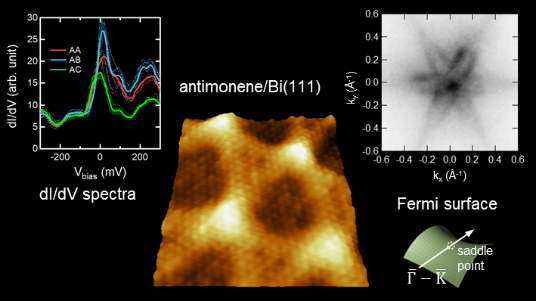Quantum Materials Field
Surface Quantum Phase Materials Group
We design and create two-dimensional quantum materials at atomically controlled surfaces and interfaces and clarify their physical properties and functionalities.
Group Leader: Takashi Uchihashi
Moiré superlattices of antimonene for 2D quantum materials
Current Topics
We have discovered that single- and double-bilayer antimony honeycomb lattices, referred to as antimonene, form moiré superlattices on a Bi(111) substrate due to lattice mismatch.Their surface bands are Rashba-type spin-plarized and possess the van Hove singularity near the Fermi level and.
Outline of Research
The advent of artificially stacked two-dimensional (2D) materials with moiré superlattices, which are induced by a lattice mismatch and/or a twist angle, has led to the development of new paradigms in condensed matter physics and materials science. This has been demonstrated by recent studies on graphene and transition metal dichalcogenides. The introduction of spin-orbit coupling (SOC), particularly, Rashba-type SOC, into moiré superlattices can lead to even richer emergent phenomena such as topological superconductivity. For this purpose, the application of elemental 2D materials with strong SOCs such as Bi and Sb may greatly expand the potential of moiré superlattices. Nevertheless, the exploration of such a possibility has been scarce thus far.

Fig. 1. Antimonene/Bi(111) moire superlattices and electronic structures clarified by scanning tunneling microscopy and angle resolved photoemission spectroscopy.
References
- T. Nakamura et al., Moiré superlattices of antimonene on a Bi(111) substrate with van Hove singularity and Rashba-type spin polarization, Commun. Mater 5, 167 (2024). DOI: 10.1038/s43246-024-00615-z
Group members
-
 Takashi Uchihashi・Group Leader
Takashi Uchihashi・Group Leader -
 Ryuichi Arafune・Principal Researcher
Ryuichi Arafune・Principal Researcher -
 Takehide Yamaguchi・Principal Researcher
Takehide Yamaguchi・Principal Researcher -
 Katsumi Nagaoka・Senior Researcher
Katsumi Nagaoka・Senior Researcher
Activities
-
Feb. 26, 2024
-
Sep. 3, 2024
-
Nov. 6, 2024
Links


